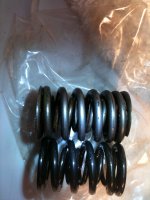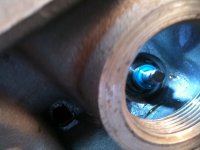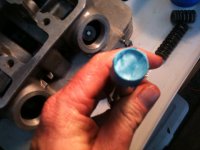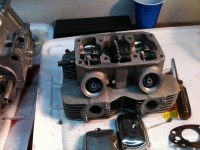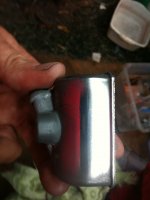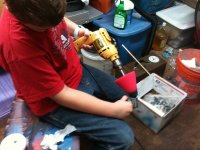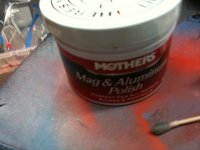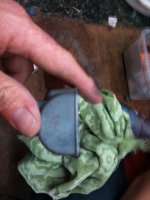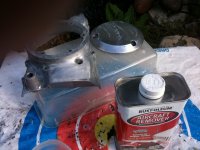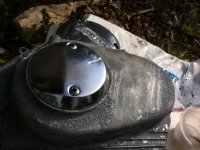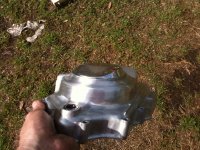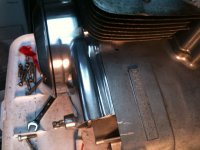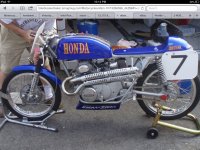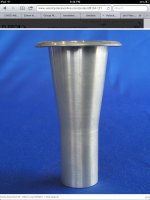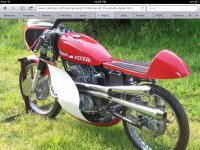We noticed you are blocking ads. DO THE TON only works with community supporters. Most are active members of the site with small businesses. Please consider disabling your ad blocking tool and checking out the businesses that help keep our site up and free.
You are using an out of date browser. It may not display this or other websites correctly.
You should upgrade or use an alternative browser.
You should upgrade or use an alternative browser.
Father Son 75 CB200T Rise From the Ruins
- Thread starter Texasstar
- Start date
Texasstar
Can't is a four letter dirty word
http://www.theriderfiles.com/2011/06/24/factory-yamaha-1967/Tim said:Any idea what year this pic is from? Wouldn't mind having a closer look at some of the racing leathers. I have a set that are similar in design - just without the stripes (solid color body with different color sleeves). I went back and forth on having stripes on the arm - but didn't. Anyhow - wouldn't mind trying to find more pics.

Kop,
what bikes were they on? Were those the YZ607 factory built RD56 with a TD1C motor to meet AMA rules of production based motor and any frame and wheels.
They were not DS7 as the article suggested at the time. Do you believe that companies lied to journalists who knew no better. Shock.
what bikes were they on? Were those the YZ607 factory built RD56 with a TD1C motor to meet AMA rules of production based motor and any frame and wheels.
They were not DS7 as the article suggested at the time. Do you believe that companies lied to journalists who knew no better. Shock.
Texasstar
Can't is a four letter dirty word
We installed vintage advantage racing springs(stock is left and the new ones right) and viton seals. Cam height measurements were well within the service limit 24.9 for the intake and 24.7 for the exhaust...our measured 25.01, 25.02, 24.97, 24.86 respectively.
Attachments
deepwaterimports
Over 1,000 Posts
looking shiny mate.
you are way more patient then me i ended up painting mine hahaha
you are way more patient then me i ended up painting mine hahaha
Texasstar
Can't is a four letter dirty word
love your build! You look pretty patientdeepwaterimports said:looking shiny mate.
you are way more patient then me i ended up painting mine hahaha
Texasstar
Can't is a four letter dirty word
We would like to run velocity stacks to see if it helps with top end performance. Now don't get mad my son and I learn from going beyond the tolerances. Well we asked y'all and Cometic how thin they have made head and base gaskets and the told us and we learned a "ton" from that question. Btw as a side note my son did his first ton in six seconds (cosworth tuned triumph) on easter in honor of Lucky. Figured Rez day was a good day. He couldn't stop giggling. We celebrated eating donuts not doing them.
Ok so I found some velocity stacks 120mm long. Now we want to run them with a foam filter but on occasion when LUCKY wants to we want to pull them off. Here is my question where is the law of diminishing returns for top speed on the length of velocity stacks?
Ok so I found some velocity stacks 120mm long. Now we want to run them with a foam filter but on occasion when LUCKY wants to we want to pull them off. Here is my question where is the law of diminishing returns for top speed on the length of velocity stacks?
Attachments
Texasstar
Can't is a four letter dirty word
Just found a jewel from Sonreir on a 4 sale post:
"As many of you may already know, CV carbs don't respond well to changes in the intake system that introduce turbulence. Turbulence, mostly, is due to pod filters and other "high flowing" intake systems. The solutions to this problem are numerous and include construction of air boxes to provide "still" air, introduction of air correction systems within the intake itself, and even sticking with the stock air box and making no intake changes whatsoever. For those whose minds are set on a solution that will provide better airflow while still allowing the use of their stock CV carbs (as opposed to a switch to Mikuni VMs or the like) a velocity stack offers itself as a good option.
A velocity stack serves a number of purposes. First and foremost, it smooths air flow entering into the intake. Smooth airflow means MORE airflow. Because the air molecules are all heading in the same direction and not fighting among themselves, you can get more air and more fuel into your cylinders. More air and more fuel means more power! Additionally, in reference to our CV carbs, smooth air means we can tune them more reliably and not be forced to a switch to VMs or similar. The secondary reason to use a velocity stack is to increase the (you guessed it) velocity of the intake charge. This is a good thing because the intake valve is still open when the piston begins its compression stroke (this is especially true for high duration cams). What this means is that if the intake charge is moving too slowly, it won't have enough inertia to overcome the increasing pressure in the cylinder caused by the rising compressing piston and the fuel/air mixture will be forced back out of the intake, costing us torque/power due to poorer cylinder filling. Finally, the tertiary purpose of a velocity stack is to change the length of your intakes. This allows you to create an intake length that will resonate at a certain frequency (RPM). This resonance creates pulses or waves of higher pressures within the intake and the object is to time one of these pulses to hit the intake valve while it's open. A well designed velocity stack will accomplish its primary and secondary purposes with little left over for you to worry about and so we will focus the remainder of this document on the resonance effect (also called pulse tuning or ram induction).
Much like small waves lapping up against the edge of a pool and then heading back toward their origin, these resonance pulses will rebound and travel back and forth along the intake tract. The number of bounces the pulse incurs before being utilized by our tuning determines how we address the pulse and also the amount of pressure the pulse creates. For instance, the third time the wave bounces back and forth is called the (funnily enough) third wave or third pulse. Just like any other wave that bounces between objects, much of its energy is spent during the reflection process and so each each higher numbered wave will have much less power than the lowered number wave before it.
"Easy!", you say. "I want the most power and so I will tune for the first wave!" Well, that's exactly what we want, in theory, but this is often quite difficult to do in practice. The speed at which these pulses travel is variable depending on your intake conditions, but is roughly the speed of sound (1125 feet per second). Now lets examine your intake system a bit more closely so we can figure out how to best capture that rebound.
Before we begin with the math, decide which range in the RPM you wish to the effect to take place. As with nearly everything in engine performance, you have to choose a "best" and in order to make the most of your machine you're better off stacking all of these "best" points at exactly the same spot and then use your gearing to keep the RPMs there. For argument's sake I will choose 8000 RPM. For the following calculations, I will also assume the stock duration for a Honda 360 which is 221°.
1.) A 4-stoke engine rotates twice for every opening of the intake valve, and so we use 720° as a starting point.
2.) To determine how long our intake valve remains closed, we take 720° and subtract the duration of our cam at 221°. The answer is that the intake is closed for 499° of the crankshaft's rotation.
3.) Now we need to figure out the number of rotations per second by taking our 8000RPM figure and dividing by 60. We have 133.33 RPS.
4.) Now convert this number to degrees per second by multiplying by 360°. We have 48000°/sec.
5.) Next, take the number of degrees the intake valve is closed and divide that by the number of degrees of rotation per second (499 / 48000) and we have .010395 seconds.
6.) Finally, we take the number of feet per second which the pulse is traveling and multiply that by the number of seconds we calculated at step 5 (1125 * .010395). The answer is 11.695 feet. Now divide this number by two because the pulse which we are measuring is, first, traveling away from the closed intake port and rebounding back to it. This gives us an ideal intake length of 5.848 feet in order to catch the first pulse.
Obviously, a six foot intake is going to be longer than many of our bikes to begin with and so capturing the first pulse is rarely, if ever, feasible. Even targeting the second pulse can be difficult and NASCAR builders usually aim for third pulse. Depending on your application you should try to get fourth pulse but can settle for as low as sixth. Knowing the necessary intake length for each pulse you capture is as simple as dividing the number we got from step six by the pulse number. For instance, to capture the fourth pulse, we divide 5.848 by 4 and get 1.462 feet, or 17.5 inches. Doable, but still long. Going down to fifth wave gets us 14.0352 inches, so we'll give that a try.
Because this is the total length of the intake and not just the length of the velocity stack, we need to first subtract the existing intake length before we can determine the length of the velocity stacks. The intake length from intake valve to carb venturi opening for a Honda 360 is 214mm. A quick metric conversion from 14.0352 inches minus 214 mm gives us 142.5 mm.
So for our particular application, we're looking for velocity stacks that are 142.55 mm in length. Simple, no?"
I love DTT.
"As many of you may already know, CV carbs don't respond well to changes in the intake system that introduce turbulence. Turbulence, mostly, is due to pod filters and other "high flowing" intake systems. The solutions to this problem are numerous and include construction of air boxes to provide "still" air, introduction of air correction systems within the intake itself, and even sticking with the stock air box and making no intake changes whatsoever. For those whose minds are set on a solution that will provide better airflow while still allowing the use of their stock CV carbs (as opposed to a switch to Mikuni VMs or the like) a velocity stack offers itself as a good option.
A velocity stack serves a number of purposes. First and foremost, it smooths air flow entering into the intake. Smooth airflow means MORE airflow. Because the air molecules are all heading in the same direction and not fighting among themselves, you can get more air and more fuel into your cylinders. More air and more fuel means more power! Additionally, in reference to our CV carbs, smooth air means we can tune them more reliably and not be forced to a switch to VMs or similar. The secondary reason to use a velocity stack is to increase the (you guessed it) velocity of the intake charge. This is a good thing because the intake valve is still open when the piston begins its compression stroke (this is especially true for high duration cams). What this means is that if the intake charge is moving too slowly, it won't have enough inertia to overcome the increasing pressure in the cylinder caused by the rising compressing piston and the fuel/air mixture will be forced back out of the intake, costing us torque/power due to poorer cylinder filling. Finally, the tertiary purpose of a velocity stack is to change the length of your intakes. This allows you to create an intake length that will resonate at a certain frequency (RPM). This resonance creates pulses or waves of higher pressures within the intake and the object is to time one of these pulses to hit the intake valve while it's open. A well designed velocity stack will accomplish its primary and secondary purposes with little left over for you to worry about and so we will focus the remainder of this document on the resonance effect (also called pulse tuning or ram induction).
Much like small waves lapping up against the edge of a pool and then heading back toward their origin, these resonance pulses will rebound and travel back and forth along the intake tract. The number of bounces the pulse incurs before being utilized by our tuning determines how we address the pulse and also the amount of pressure the pulse creates. For instance, the third time the wave bounces back and forth is called the (funnily enough) third wave or third pulse. Just like any other wave that bounces between objects, much of its energy is spent during the reflection process and so each each higher numbered wave will have much less power than the lowered number wave before it.
"Easy!", you say. "I want the most power and so I will tune for the first wave!" Well, that's exactly what we want, in theory, but this is often quite difficult to do in practice. The speed at which these pulses travel is variable depending on your intake conditions, but is roughly the speed of sound (1125 feet per second). Now lets examine your intake system a bit more closely so we can figure out how to best capture that rebound.
Before we begin with the math, decide which range in the RPM you wish to the effect to take place. As with nearly everything in engine performance, you have to choose a "best" and in order to make the most of your machine you're better off stacking all of these "best" points at exactly the same spot and then use your gearing to keep the RPMs there. For argument's sake I will choose 8000 RPM. For the following calculations, I will also assume the stock duration for a Honda 360 which is 221°.
1.) A 4-stoke engine rotates twice for every opening of the intake valve, and so we use 720° as a starting point.
2.) To determine how long our intake valve remains closed, we take 720° and subtract the duration of our cam at 221°. The answer is that the intake is closed for 499° of the crankshaft's rotation.
3.) Now we need to figure out the number of rotations per second by taking our 8000RPM figure and dividing by 60. We have 133.33 RPS.
4.) Now convert this number to degrees per second by multiplying by 360°. We have 48000°/sec.
5.) Next, take the number of degrees the intake valve is closed and divide that by the number of degrees of rotation per second (499 / 48000) and we have .010395 seconds.
6.) Finally, we take the number of feet per second which the pulse is traveling and multiply that by the number of seconds we calculated at step 5 (1125 * .010395). The answer is 11.695 feet. Now divide this number by two because the pulse which we are measuring is, first, traveling away from the closed intake port and rebounding back to it. This gives us an ideal intake length of 5.848 feet in order to catch the first pulse.
Obviously, a six foot intake is going to be longer than many of our bikes to begin with and so capturing the first pulse is rarely, if ever, feasible. Even targeting the second pulse can be difficult and NASCAR builders usually aim for third pulse. Depending on your application you should try to get fourth pulse but can settle for as low as sixth. Knowing the necessary intake length for each pulse you capture is as simple as dividing the number we got from step six by the pulse number. For instance, to capture the fourth pulse, we divide 5.848 by 4 and get 1.462 feet, or 17.5 inches. Doable, but still long. Going down to fifth wave gets us 14.0352 inches, so we'll give that a try.
Because this is the total length of the intake and not just the length of the velocity stack, we need to first subtract the existing intake length before we can determine the length of the velocity stacks. The intake length from intake valve to carb venturi opening for a Honda 360 is 214mm. A quick metric conversion from 14.0352 inches minus 214 mm gives us 142.5 mm.
So for our particular application, we're looking for velocity stacks that are 142.55 mm in length. Simple, no?"
I love DTT.
Texasstar
Can't is a four letter dirty word
Did you start your build yet? When everybody zigs we zag. Do you know how many times in my life I was told not to do something? Yea and all those guys have turbulence issues with their carbs once they slap their pods on. If you are serious about doin the ton with an 80mph bike then you are gonna need velocity stacks.Luugo86 said:Haha.. I was thinking of velocity stacks, but no one seems to condone them or use them so I kinda got off the idea. Hope you had a good holiday weekend man. Cheers.
,Dave
Turnturtle
Been Around the Block
Take a look at this article on the design of velocity stacks. Its one of the references to the Wikipedia entry on velocity stacks. He (Dr. Blair) discusses length, opening and shape. http://www.profblairandassociates.com/pdfs/Bellmouth.zip
deepwaterimports
Over 1,000 Posts
Some of the boys on here may help you. Unsure if you have read this thread at all but it's pretty interesting.
http://www.dotheton.com/forum/index.php?topic=39814.30
http://www.dotheton.com/forum/index.php?topic=39814.30
Texasstar said:I love DTT.
Me, too. ;D
Texasstar
Can't is a four letter dirty word
yea baby! 2 believers! You can get by with a little help from your friends! You can fly with a little help from your friends! I may need a rocket pack strapped to my back though LOL! Thanks y'all are now hereby made hon'ry Texans! What do you get when a Dutchman is a Texan? I will read ev'ry word!deepwaterimports said:Some of the boys on here may help you. Unsure if you have read this thread at all but it's pretty interesting.
http://www.dotheton.com/forum/index.php?topic=39814.30


